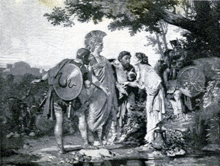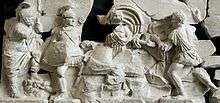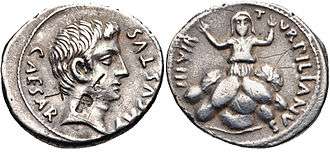Tarpeia


In Roman mythology, Tarpeia /tɑːrˈpiːə/, daughter of Spurius Tarpeius (a Roman commander) was a Roman maiden who betrayed the city of Rome to the Sabines in exchange for what she thought would be a reward of jewellery. She was instead crushed to death and her body cast from the Tarpeian Rock which now bears her name.[1]
Legend

The legend tells that while Rome was besieged by the Sabine king Titus Tatius, Tarpeia, daughter of the commander of the citadel, Spurius Tarpeius, approached the Sabine camp and offered them entry to the city in exchange for "what they bore on their left arms". Greedy for gold, she had meant their bracelets, but instead the Sabines threw their shields—carried on the left arm—upon her, crushing her to death. Her body was then hurled from (or, according to some accounts, buried at) a steep cliff of the southern summit of the Capitoline Hill. The cliff was named the Tarpeian Rock after its victim,[2] and would become known as the place of execution for Rome's most notorious traitors. The Sabines were however unable to conquer the Forum, its gates miraculously protected by boiling jets of water created by Janus.[2]
The legend was depicted in 89 BC by Sabinus following the Civil Wars as well as on a silver denarius of the Emperor Augustus in approximately 20 BC. Tarpeia would later become a symbol of betrayal and greed in Rome.[3]
See also
Sources
- Livy, Ab Urbe condita, 1:11.
- Propertius, IV.4
References
- ↑ Sanders, H. (1904). Roman historical sources and institutions. Macmillan. pp. 1–47.
- 1 2 Morford, M.; Lenardon, R. (1999). Classical mythology. Oxford University Press. p. 536. ISBN 978-0-19-514338-6.
- ↑ "Denier d'argent, Rome, vers 20/18 avant J.C." (in French). Retrieved 2009-06-28.
